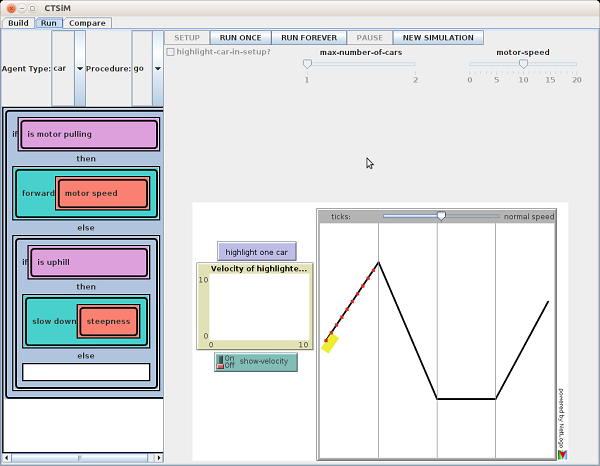
The CTSiM Construction World for a kinematics unit
Computational Thinking in Simulation and Model-Building (CTSiM)
CTSiM is an educational program for STEM disciplines that combines the use of visual programming, modeling, and simulation to promote guided, exploratory learning in a computational thinking framework. In the environment, students use a visual programming language to build computational models of different science phenomena, which they can then simulate and compare against the results generated by expert simulations. Student learning during the modeling, simulation, and verification tasks are guided by online resources and a scaffolding framework that supports guided discovery. More information about the project can be found here.
Computational thinking is a term which was coined by Jeannete Wing in 2006 [1]. It is loosely defined as a tool set for solving problems that combines the use of abstractions, automation, and symbolic and logical reasoning that have been primarily developed in the computer sciences and general mathematical primitives to build and analyze computational models of processes. Since 2006, many in the education community have echoed Wing's call about the importance of teaching students how to think computationally. The CTSiM environment attempts to teach students how to use Computational Thinking in the wider context of STEM disciplines. One of our goals is to use this environment to help students develop deep understanding of science and mathematics concepts that they can th en apply in engineering problem-solving.
The current version of CTSiM seeks to make the creation of complex and meaningful science models accessible to students at the middle school level [2]. Each science unit in CTSiM has a set of pre-defined computational primitives that help the student to construct behaviors and phenomena that are specific to the science domain that the student is learning. We believe this process of computationally defining behavior models and observing them in simulations can provide the students with a deep understanding of the science phemonema. The ease of using the interface (drag and drop actions) to build the models allows students to focus more on the modeling and science aspects of creating models and less on the syntax of programming. The computational framework also provides the framework for studying useful cross-domain primitives that should allow for knowledge transfer and generalization across domains.
The program interface is split into three main worlds (or activities) for students. Students build the computational models in Construction World, which they can then simulate in the Enactment World. Students can view their code side-by-side with the model execution, allowing them to debug and mentally connect code blocks to observed model behavior. The third world is the Envisionment World which allows studnets to view the output of their model alongside the output of an "expert" model. Running scientific experiments to compare against the expert model assists students in focusing on model behavior (as opposed to code) and gives students a reference for correct model execution.
Studies
CTSiM was first piloted in May 2012 at a magnet middle school in Nashville, TN. During this study, students worked on a progression of kinemtics and ecology models, and they received individual monitoring and assistance from our researchers. We are currently working on developing and implementing scaffolds within the CTSiM environment.
[1] J.M. Wing. (2006) Computational Thinking. CACM 49(3):33-35.
[2] We are also working with a few high school teachers to develop mathematics and science curricular units in the CTSiM learning environment.

The CTSiM Construction World for a kinematics unit

The CTSiM Enactment World

The CTSiM Envisionment World